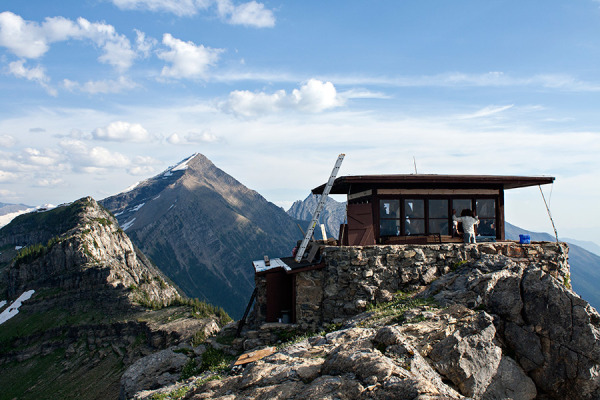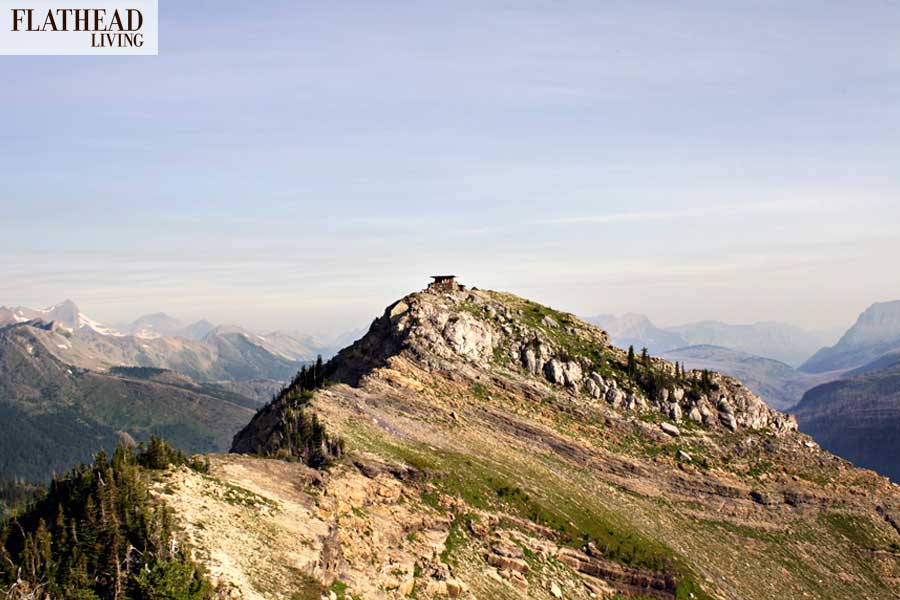Editor’s Note: This is one of the stories featured in the fall edition of Flathead Living magazine. Pick up a free copy on newsstands throughout the valley.
Perched on the remote north shoulder of Heaven’s Peak, on the edge of an abrupt, 1,000-foot drop, this mountain’s namesake fire lookout looms over one of the most rugged portions of Glacier National Park, where steep mountainsides bristle with dense forests of alder and devil’s club, supporting the highest concentration of grizzly bears in the entire Northern Continental Divide Ecosystem and relegating human traffic to a negligible trickle.
Built into the existing rock and anchored to a prominent point on the 7,245-foot-high ridge, the native stonemasonry employed 70 years ago by members of the historic peace churches – conscientious objectors to World War II – remains intact, giving the structure the organic appearance of sprouting from the landscape.
These workers were Mennonites, Amish, Hutterites, Quakers, Jehova’s Witnesses, and even some Baptists and Mormons who, as members of the Civilian Public Service, made a long list of contributions to the park, including firefighting, trail maintenance, and organizing and cataloging the park’s library holdings.
They also built one of Glacier National Park’s most enduring manmade legacies, a lookout that was active from its construction in 1945 through the 1953 fire season when, along with the Mount Reynolds and Bear Mountain lookouts, it was abandoned in favor of aerial wildfire detection.
The structure was listed in the National Register of Historic Places in 1986 and represents one of the last remaining structures built by the CPS in the country.
However, it has passed into desuetude in recent decades as extreme weather conditions and a lack of maintenance have taken a toll on the lookout’s historic fabric – a deteriorating roof and floor, missing shutters and windows, and a lack of paint have threatened the building’s long-term survival.
But a recent visit to the fire lookout revealed marked improvements following a three-year project to stabilize the structure.
In 2011, park officials, recognizing that the lookout could be lost, launched a “stabilization project,” which was largely completed at the end of this summer, thanks in part to the donation of time, resources and labor by descendants of the original CPS crew members.
Family members of the mostly Mennonite workers who built Heaven’s Peak Fire Lookout have especially invested in ensuring the iconic lookout tower remains part of the landscape for another 70 years.

Milton Headings, a 51-year-old Mennonite from Buffalo, Missouri, recalls his father, the late Daniel Headings, regaling his childhood community with tales of living and working at the Heaven’s Peak side camp, warding off grizzly bears with slingshots and packing gear, hauling equipment and tools to the ridge by mule.
Since hearing those childhood renderings of the mystical Heaven’s Peak, Headings has visited the lookout twice – once with his father and once for a multi-week hitch to help stabilize the structure. The majority of his 14 children have braved the tortuous hike to the lookout, the allure of which is lost on none of them.
“My dad helped build it in 1944 and 1945 and he would talk about the experience day after day after day. How they did that back then was quite a feat but he thought of that as one of the happiest times of his life,” Headings said.
Far from dominating the landscape, the Heaven’s Peak Fire Lookout appears as a tiny diadem studding the long ridge’s northernmost flank, discernible from the Going-to-the-Sun Road only to visitors with a keen eye who know where to look, and accessible only by the hardiest hikers willing to endure a sanity-testing bushwhack.
Still, the stabilization project took place in proposed wilderness and required an environmental analysis and review process, due in part to its need for helicopter support not permitted by the Wilderness Act.
Former Glacier National Park Superintendent Chas Cartwright disagreed with opponents of the project who complained that it did not fall within the mission of the National Park Service and was inferior to the spirit of a wilderness designation.
“The Heaven’s Peak Lookout is not only an integral part of Glacier’s cultural legacy, but also contributes to the unique character of the park’s wilderness landscape,” Cartwright said in response.
Albert H. Good, editor of the National Park Service’s 1938 book “Park Structures and Facilities,” was the architect for the structure. Good’s design for Heaven’s Peak put into practice his suggestion to use native rock for lookouts on prominent points, “especially if, when located on a rocky summit, the structure is blended to it and made to appear to grow out of it.”
“Designed and constructed to merge with the rugged backcountry terrain, the lookout has become part of the Heaven’s Peak wilderness setting and contributes historical value to the overall wilderness character of the park,” according to the park service.

Under the guidance of project manager Jack Polzin, whose backcountry carpentry chops Cartwright characterized as having “done more for historic preservation in Glacier National Park than anyone else,” the stabilization began in July 2011 and wrapped up over the Labor Day weekend.
The project did not include blazing a new trail, and visitation to the lookout will likely not see an uptick, Polzin said.
Accessing the lookout requires a challenging climb and treacherous bushwhack from the east side of the mountain from Packer’s Roost. The west side approach is mostly by trail to Camas Lake, but the trail is overgrown and tenuous. From Camas Lake, a hiker then has to scramble up 1,500 feet of rock and scree to the lookout site. Still other routes require difficult climbs and route finding.
Nonetheless, descendants of those original CPS crewmembers have visited the site in droves, and reunions were frequent until Daniel Headings, one of the last original crewmembers, passed away two years ago.
“It was a life-changing event for some of these family members to come up here. Family and friends continue to come up over the ensuing decades, helping financially and with labor to stabilize the site,” Cartwright said.
The Civilian Public Service camp filled a gap left open by the abrupt conclusion of the Civilian Conservation Corps in 1942, and signaled a progressive tolerance by the United States of conscientious objectors – as recently as World War I, those who objected to conscription for religious, philosophical or political reasons were jailed in Great Britain.
The Glacier Civilian Public Service camp at Belton, called Camp No. 55, housed more than 550 men during the four years of its operation, but the two-dozen men who worked on the Heaven’s Peak Fire Lookout accomplished a rarefied feat in remote territory.
An August 1945 CPS newsletter titled “Project Takes Men to Side Camps, Some in Isolated Areas,” signals a departure from terra firma for the crews:
“The Heaven’s Peak Side Camp is unique in that it is located at an elevation of 6,000 feet on the side of a mountain, namely Heaven’s Peak. The project of this camp is building a lookout, materials for which have to be packed up entirely by mule pack, 1,200 feet above the camp site. Setting up the camp and repairing the trails leading to the lookout was the main project for about a month.”
According to crewmember Josh Mishler, “the boys enjoy fishing, swimming, ping pong and many other sports which add to the camp life. Harvey often brings in a nice catch of fish which, when fried, soon find their spot. Looking towards the head of the lake, the campees have one of the most scenic views of the park. The deep blue water with the towering mountains going almost straight up on each side of the lake is a sense that is most magnificent.”
In his book “Rather than War: The Story of Civilian Public Service Camp #55, Belton, Montana,” Dave Walter described the Civilian Public Service camp as a means for conscientious objectors to perform work of national significance and “contribute to the welfare of the nation without bearing arms against another human being.”
Other than a little bit of federal money, the project was funded by the Glacier National Park Fund and cost approximately $40,000.
Views in every direction are amongst the most striking in the park. The entire Lewis and Livingston ranges lie to the north, the intricately folded strata of Mount Vaught to the south and, beyond, even Cannon Mountain cannot eclipse the colossal dome of Mount Jackson. To the east is the Garden Wall and, below, the verdant McDonald Valley, while to the west lie a string of lakes bejeweling the Camas Valley, including Evangeline Lake at the foot of Longfellow Mountain and Paul Bunyan’s Cabin.
“There is this feeling that you get up there. It’s exhilarating,” Headings said. “It’s hard to explain. But it’s the same feeling my dad and those men had back then. For myself, for my family, there’s something to gain from that.”
